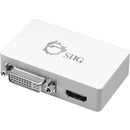Description
Unlock the full potential of your workstation with the SIIG USB 3.0 to HDMI/DVI Dual Display Adapter. This compact, plug‑and‑play solution adds one HDMI and one DVI port to your computer through a single USB 3.0 connection, enabling vibrant dual display capabilities without opening your system or installing complex internal components. Whether you’re presenting to clients, designing multimedia projects, coding with multiple reference screens, or simply expanding your home office setup, this adapter delivers reliable performance, versatile display modes, and broad compatibility across Windows and Mac platforms. Its lightweight form factor makes it an ideal travel companion for professionals who need a quick, dependable way to upgrade a laptop into a multi‑monitor powerhouse.
- Seamless dual‑display expansion via USB 3.0: Plug in one HDMI display and one DVI display to a laptop or desktop through a single USB 3.0 port. This eliminates the need to install an additional graphics card, keeps your system portable, and makes it easy to scale your workspace for presentations, data dashboards, or creative workflows on the go.
- Flexible display modes for every scenario: Choose Primary to designate a main screen, Mirror to duplicate your content across both displays, or Extended to create a larger desktop area. These modes empower you to optimize your layout for meetings, design reviews, coding sessions, or content creation with multiple windows and tool panels.
- Plug‑and‑play setup with broad compatibility: The adapter is designed for straightforward setup with a wide range of monitors and projectors. After installing the drivers, you can quickly configure resolutions, color depth, and orientation to suit your needs—whether you’re running a Windows PC or a MacBook alongside external displays.
- Compact, portable form factor for travel and in‑office use: The lightweight adapter travels easily in a laptop bag or briefcase, enabling a quick screen upgrade for conference rooms, classrooms, or remote work environments. Its unobtrusive footprint helps keep your desk clean while delivering powerful multi‑monitor capabilities.
- Reliable performance with efficient USB 3.0 bandwidth: Built to deliver smooth playback, crisp visuals, and responsive window management across two displays, the adapter leverages USB 3.0 bandwidth to minimize latency and maximize productivity while maintaining system reliability.
Technical Details of SIIG USB 3.0 to HDMI/DVI Dual Display Adapter
- Interface: USB 3.0 connection to a host computer with two video outputs—one HDMI and one DVI—for simultaneous dual‑display expansion.
- Supported operating systems: Works with Windows and macOS platforms, supported by appropriate drivers to ensure stable display performance.
- Display modes: Primary, Mirror, and Extended modes to support a wide range of workflows, from presentations to multitasking layouts.
- Power and bus: Powered via the USB 3.0 bus; typically no external power supply is required for standard configurations, keeping setup simple and portable.
- Design and build: A compact, durable adapter designed for everyday use, travel, and desktop setups without adding bulk to your workstation.
how to install SIIG USB 3.0 to HDMI/DVI Dual Display Adapter
Follow these steps to establish a reliable dual‑display setup. The process is designed to be straightforward for users of all skill levels, with compatibility across common Windows and Mac configurations.
- Step 1: Connect the USB 3.0 plug on the adapter to an available USB 3.0 port on your computer. For best results, use a direct USB 3.0 port on the device rather than a hub, ensuring maximum bandwidth for video output.
- Step 2: Install the driver software. Use the installer provided with the adapter or download the latest drivers from the official SIIG support site. Driver installation ensures the operating system recognizes the HDMI and DVI outputs and configures optimal performance for your displays.
- Step 3: Attach your displays. Connect an HDMI cable to the HDMI port on the adapter and a DVI cable to the DVI port. Verify that both displays are powered on and set to the appropriate input sources. If necessary, adjust cable lengths to avoid signal degradation.
- Step 4: Configure display settings in your operating system. On Windows, open Display Settings to arrange the relative positions of the monitors, choose Extended or Mirror modes, and designate a primary display. On macOS, use System Preferences > Displays to arrange the desktop and select the desired arrangement or mirroring options.
- Step 5: Test and fine‑tune. Drag windows between screens, test video playback or a presentation, and confirm color depth, resolution, and refresh rate are set to your preference. If you encounter any issues, revisit driver updates or system compatibility notes from the manufacturer for troubleshooting tips.
Frequently asked questions
- Q: Can I run two external monitors concurrently from a single USB 3.0 port? A: Yes. The adapter is designed to drive one HDMI display and one DVI display at the same time through a single USB 3.0 connection on compatible Windows or Mac systems.
- Q: Do I need an external power supply? A: In most configurations, no additional power is required as the USB 3.0 bus supplies the necessary power. However, some high‑resolution setups or long cable runs may benefit from extra power or adjustments to display settings.
- Q: Which resolutions are supported? A: Supported resolutions depend on your host computer, the operating system, and the connected displays. The adapter supports standard HD and high‑definition configurations; 1080p output on each display is common for typical setups, with higher or lower resolutions determined by the system capabilities.
- Q: Is there driver software required? A: Yes. Driver software is typically required to ensure full compatibility with Windows or macOS. Install the package from the included media or download the latest version from the manufacturer’s site to maximize performance and stability.
- Q: Can I use this adapter with both Windows and macOS? A: Yes. The adapter is designed for cross‑platform use, offering compatible drivers and support for supported Windows and macOS environments to enable seamless dual‑display experiences.
Customer reviews
Showing - Of Reviews


